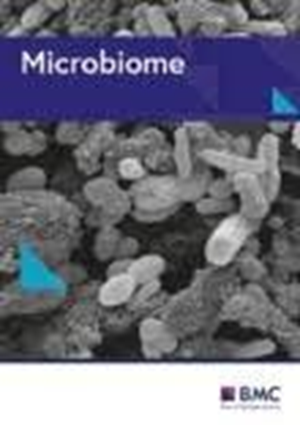Bacteroides uniformis degrades β-glucan to promote Lactobacillus johnsonii improving indole-3-lactic acid levels in alleviating colitis
IF 13.8
1区 生物学
Q1 MICROBIOLOGY
引用次数: 0
Abstract
Intake of dietary fiber is associated with a reduced risk of inflammatory bowel disease. β-Glucan (BG), a bioactive dietary fiber, has potential health-promoting effects on intestinal functions; however, the underlying mechanism remains unclear. Here, we explore the role of BG in ameliorating colitis by modulating key bacteria and metabolites, confirmed by multiple validation experiments and loss-of-function studies, and reveal a novel bacterial cross-feeding interaction. BG intervention ameliorates colitis and reverses Lactobacillus reduction in colitic mice, and Lactobacillus abundance was significantly negatively correlated with the severity of colitis. It was confirmed by further studies that Lactobacillus johnsonii was the most significantly enriched Lactobacillus spp. Multi-omics analysis revealed that L. johnsonii produced abundant indole-3-lactic acid (ILA) leading to the activation of aryl hydrocarbon receptor (AhR) responsible for the mitigation of colitis. Interestingly, L. johnsonii cannot utilize BG but requires a cross-feeding with Bacteroides uniformis, which degrades BG and produces nicotinamide (NAM) to promote the growth of L. johnsonii. A proof-of-concept study confirmed that BG increases L. johnsonii and B. uniformis abundance and ILA levels in healthy individuals. These findings demonstrate the mechanism by which BG ameliorates colitis via L. johnsonii–ILA–AhR axis and reveal the important cross-feeding interaction between L. johnsonii and B. uniformis.均匀乳杆菌降解β-葡聚糖,促进约翰逊乳杆菌改善吲哚-3-乳酸水平,从而缓解结肠炎
膳食纤维的摄入与炎症性肠病风险的降低有关。β-葡聚糖(BG)是一种具有生物活性的膳食纤维,对肠道功能具有潜在的健康促进作用;然而,其潜在机制仍不清楚。在这里,我们探讨了 BG 通过调节关键细菌和代谢产物在改善结肠炎中的作用,并通过多个验证实验和功能缺失研究证实了这一点,同时揭示了一种新型的细菌交叉喂养相互作用。BG 干预可改善结肠炎并逆转结肠炎小鼠体内乳酸杆菌的减少,乳酸杆菌的丰度与结肠炎的严重程度呈显著负相关。多组学分析表明,约翰逊乳杆菌产生大量的吲哚-3-乳酸(ILA),导致芳香烃受体(AhR)被激活,从而缓解结肠炎。有趣的是,约翰逊酵母菌不能利用 BG,而需要与均匀乳杆菌(Bacteroides uniformis)交叉喂养,后者会降解 BG 并产生烟酰胺(NAM),以促进约翰逊酵母菌的生长。一项概念验证研究证实,BG 能增加健康人体内约翰逊酵母菌和均匀酵母菌的数量和 ILA 水平。这些发现证明了 BG 通过 L. johnsoniii-ILA-AhR 轴改善结肠炎的机制,并揭示了 L. johnsonii 和 B. uniformis 之间重要的交叉摄食相互作用。
本文章由计算机程序翻译,如有差异,请以英文原文为准。
求助全文
约1分钟内获得全文
求助全文
来源期刊

Microbiome
MICROBIOLOGY-
CiteScore
21.90
自引率
2.60%
发文量
198
审稿时长
4 weeks
期刊介绍:
Microbiome is a journal that focuses on studies of microbiomes in humans, animals, plants, and the environment. It covers both natural and manipulated microbiomes, such as those in agriculture. The journal is interested in research that uses meta-omics approaches or novel bioinformatics tools and emphasizes the community/host interaction and structure-function relationship within the microbiome. Studies that go beyond descriptive omics surveys and include experimental or theoretical approaches will be considered for publication. The journal also encourages research that establishes cause and effect relationships and supports proposed microbiome functions. However, studies of individual microbial isolates/species without exploring their impact on the host or the complex microbiome structures and functions will not be considered for publication. Microbiome is indexed in BIOSIS, Current Contents, DOAJ, Embase, MEDLINE, PubMed, PubMed Central, and Science Citations Index Expanded.
 求助内容:
求助内容: 应助结果提醒方式:
应助结果提醒方式:


